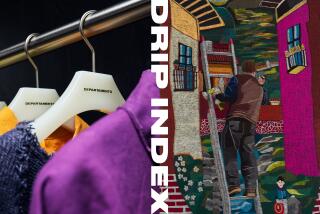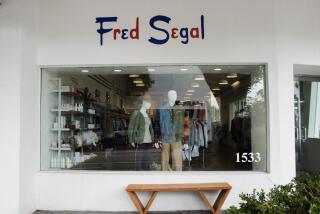Has Fred Segal gone from L.A. cool to tepid with moves to LAX, Vegas?
Once upon a time, Fred Segal was the epitome of SoCal cool — a collection of stores where shoppers discovered the next big thing, where designers pitched their wares hoping to be discovered, where other retailers walked the floor hoping some of its magic would rub off.
It’s difficult to imagine any other retailer rivaling Fred Segal — name-checked in films such as “Clueless,” “Legally Blonde” and “Less Than Zero” — for sheer “L.A.-ness.”
That’s why many a perfectly arched eyebrow was raised in May 2012 with the announcement that the worldwide rights to the Fred Segal name — but not the two existing Fred Segal centers in Los Angeles and Santa Monica — had been sold to Sandow, a New York City media company.
The first manifestation of Fred Segal 2.0 came in September 2013 in the form of a 2,000-square-foot store in the revamped Tom Bradley International Terminal at Los Angeles International Airport. The space references its heritage with a photo-printed, backlit version of the ivy covering the original Melrose Avenue center with the name Fred Segal spelled in red, white and blue letters.
But inside, things are a bit different. The shop stocks the first two branded Fred Segal products — old-fashioned glass jars of candy and a 10-pack of perfume oils called the Blend — alongside L.A. labels such as Clare Vivier, J. Brand and Baxter of California. The second location, which opened in late August at the SLS Las Vegas Hotel, is a collective of seven stores representing the resort’s entire retail component, stocked with a similar range of apparel, footwear, accessories, denim and gifts.
An airport, a Las Vegas hotel and logo-branded gifts? It raises the question: Could Fred Segal be headed the way of Kitson kitsch — less fashion with a capital F and more logo-ed tourist tchotchkes?
Let’s face it. Fred Segal hasn’t been the same for some time. It no longer lands on lists of the best stores in L.A. or plays much of a role in discovering and promoting new design talent. The stores were once packed on weekends, but now parking spots are readily available.
In some ways, the retailer may be a victim of its own success, with so many of the things it pioneered now commonplace in stores around the world.
As a young entrepreneur in 1961, founder Fred Segal unleashed the first wave of designer denim mania (when jeans were retailing for $3.98, he priced his at $19.95) and promptly had customers lining up around the block. He saw potential in the blue jean business, opening a novel denim bar concept that retailers such as Gap and Macy’s have since embraced.
What truly made him a retail visionary, though, was pioneering the shop-in-shop concept that is now standard practice in department stores. Segal served as the original savvy landlord, clustering a highly curated collection of cutting-edge, independent retailers inside his ivy-covered walls, first on Melrose in 1965, and later on Broadway in Santa Monica. With their ability to spot the next big thing, those deputized curators of cool — Ron Herman and Ron Robinson among them —– helped establish Segal’s centers as retail must-visits. And, as a de facto extension of the wardrobe departments for many a fashion-influencing TV show (“Melrose Place” and “Friends” among them), the centers helped define a certain brand of SoCal style that’s now as common a sight in Montmartre as it is in Malibu.
“What made Fred Segal magical, number one, was Fred Segal the person,” said Jeannine Braden, whose store, Fred Segal Flair, was part of the Santa Monica center for 18 years before closing in 2010. “He hand-picked the [store] owners for his centers, and the passion of the owners brought the magic to the center. Another part of the magic was that we were the epitome of Southern California cool. There wasn’t one place you could go and have that for a very long time. ... Does it have the same reputation today? I think it’s lost a little bit of it but I think it can have it again — if they can find a way to brand that grass-roots feeling and not just make it feel clinical.”
Like Braden, many of the key players in the early success have since gone. Segal himself retired in 1987. John Eshaya — who’d been on board since 1984 and had worked his way up to creative director, vice president and womenswear buyer for the Ron Herman at Fred Segal store — left in 2008 to launch his own line. And in 2011 Stanley and Patti Silver sold their landmark shoe store Fred Segal Feet to Dallas-based Gregory’s.
“[Fred Segal] still has a really strong name and reputation,” said Eshaya, whose JET brand has a store in the Santa Monica center. “For tourists and people who want to know what’s really going on, Fred Segal is their first stop after the airport. It’s one of the only California clothing institutions.”
Ron Robinson, who worked for Fred Segal for nine years and has been a retail tenant of the Melrose center for 37, said the biggest challenge for Sandow or anyone else trying to expand the brand is to preserve the integrity and heritage of what was forged by the tenants over the decades. “We have this brand that’s come from organic growth, natural growth,” Robinson said. “The challenge is interpreting and reproducing that energy in these other locations that they’re considering. ... It’s easy to take a picture of something and reproduce it, but you can’t photograph energy and you can’t photograph interaction with people. How do you get that? That’s more intrinsic and difficult to achieve — [but] not impossible.”
The new owners of the brand insist that they’ll do what it takes to preserve that heritage; they say that Fred Segal has the potential to shape the future of the retail experience just as profoundly as it has its past.
“[Fred Segal will have that same curation it always has, giving entrepreneurs an opportunity, creating things people have never seen before, creating products you can’t get anywhere else, creating a hangout,” said Adam Sandow, chairman and chief executive of Sandow. “All these things are the exact DNA Fred built into the Melrose [center, and] we want to do it on a bigger scale. ... We’re going to take our time with it and build these absolutely experiential spaces that will change what retail is. I know that’s kind of a bold thing to say, especially [coming] from a guy that isn’t a retailer.”
Sandow’s company, founded in 2003, includes luxury magazine holdings (titles such as Worth, NewBeauty, Watch Journal and Luxe Interiors + Design) and a creative management company (Culture + Commerce, which represents creatives such as Philippe Starck and Lenny Kravitz), among other things. Prior to the Fred Segal deal, the company’s bricks-and-mortar experience consisted of a chain of 185 newsstands in private airports around the country.
Sandow insists that the LAX store and SLS project are but two iterations of the brand’s future, baby steps toward what he’s calling “Fred Segal lifestyle centers.”
“I want them to be incubators of new talent,” Sandow said, “and there will be exercise and food and activity, and you’ll want to hang [out]. That’s the word I kept hearing. People would go to Fred Segal and ‘hang out,’ and that doesn’t happen anymore.”
Sandow is short on specifics — the first of the lifestyle centers won’t open until next year — but he said the goal will be to capture the feeling of discovery that once defined visiting one of the original Fred Segal locations.
He underscores how important the Fred Segal brand is by pointing out that, for the first time, his privately held company has taken on an investor to help with the brand expansion — a private equity group whose partners include Creative Artists Agency. And, in May, Sandow hired a dedicated Fred Segal chief executive, Paul Blum, whose résumé includes stints as chief executive of Juicy Couture, David Yurman and Kenneth Cole.
Blum said that although some future Fred Segal stores will look and feel like the ones at LAX and the SLS and will be at other airport and hotel properties around the world, he thinks the true longevity of the brand lies in larger “experiential retail” centers in the 10,000- to 50,000-square-foot range.
“Food and lounging and places to be comfortable and spend time while [customers are] shopping is a big part of our concept,” he said. “We’re looking at adding wellness aspects to it because we think that people don’t just shop anymore, that they want some other types of experiences, whether it’s yoga studios, exercise studios, ways for people to improve their health [as well as] grooming, hair care and things like that.”
According to Tom Julian, director of strategic business at retail and merchandising consulting firm Doneger Group, the “lifestyle center” concept fits the bill for a wide range of consumers. “In warm weather or cold weather, these new village settings help to create a vacation spot for suburbia,” Julian said. “Many retail concepts are getting more varied and unique — here in NYC, the newest Urban Outfitters has a hair salon, music shop, Intelligensia coffee shop as well as vintage boutique and beauty department. The unique merchandise mix helps to entice a shopper who may be uninspired by the ‘cookie cutter’ or uniform store concepts found in most big malls.”
Blum is adamant that the future Fred Segal will not be a purveyor of SoCal cliches, à la Kitson. “I’m not interested in simply showcasing the L.A. look,” he said. “There’s a Zen expression I like to use. ‘Don’t try to follow in the footsteps of masters, seek what they sought.’ ”
Whether or not that search is a success remains to be seen. The first inkling will probably come when the first new Fred Segal lifestyle center opens in Tokyo next spring. Additional locations, both inside and outside the U.S., are in the works for late 2015 and 2016.
Michael Segal, Fred’s son and the family member who helped shepherd the Sandow deal to completion, declined to be interviewed but voiced, via email, his thoughts on the new stewards of the brand.
“I support their efforts,” he wrote. “My family and I love Fred Segal, and we are grateful that our name, which we nurtured for 50 years, is in strong and respectful hands.”
Twitter: @ARTschorn
More to Read
Sign up for The Wild
We’ll help you find the best places to hike, bike and run, as well as the perfect silent spots for meditation and yoga.
You may occasionally receive promotional content from the Los Angeles Times.







